
Over ten years after 9/11, the persistence of hate attacks targeting Sikhs in the US, whether in the form of bullying in  schools, vandalism of gurdwaras, or even cold blooded murder, is a sobering reality for our community. Jodha and I have both discussed elsewhere that the root cause of much of the anti-Sikh violence we see in the United States is the overwhelming vilification of Muslims and Islam in our country, and in the world, today. Nevertheless, it is imperative that we have sound data about anti-Sikh attacks specifically so we fully understand the scope of the problem and thus can address it effectively.
schools, vandalism of gurdwaras, or even cold blooded murder, is a sobering reality for our community. Jodha and I have both discussed elsewhere that the root cause of much of the anti-Sikh violence we see in the United States is the overwhelming vilification of Muslims and Islam in our country, and in the world, today. Nevertheless, it is imperative that we have sound data about anti-Sikh attacks specifically so we fully understand the scope of the problem and thus can address it effectively.
It may surprise you that the US government does not in any way keep track of hate crimes targeting Sikhs. Even in the midst of the surge in attacks against Sikhs in the wake of 9/11/01, the FBI never kept track of anti-Sikh crimes. While some of us may not see the FBI as the most trustworthy of agencies to protect our communities and our civil rights given its history of spying and repression, it is nevertheless outrageous that there isn’t even a “Sikh” box to be checked when a hate crime has been reported. It says a lot about the continued marginalization and relative invisibility of our community in the United States.
This past weekend, CSU East Bay’s Ethnic Studies Department and Sikh Studies Chair along with the Jakara Movement held its third annual Sikholars Conference. Along with the 11 graduate students from all over North America, nearly 100 community members came together to share and engage in their research projects.
Opening on Saturday, Dr. Jaideep Singh welcomed the participants and discussed the burgeoning field of “Sikh Diasporic” studies that is finally beginning to bear fruit. The first panel showcased the projects of Bandana Kaur, a Yale graduate, on issues of ecofeminism, biodiversity, and social effects of the Green Revolution and Guneeta Kaur Bhalla on the challenges, development, and prospects of the 1947 Partition Archive. Both projects bring together social histories and the voices of non-elite subalterns to the fore.
The second panel, titled the “Identities of Law”, explored Sikh-Americans in a legal context. Jasmine Singh discussed the “racialization” of Sikhs in the United States, while Kiran Preet Dhillon reflected on the ways that Title VII, instead of promoting accommodation to religion in the workplace, have served to limit and demean. She called for a rigorous opening of the conversation with groups that fight for freedom from discrimination in the workplace, including SALDEF and the Sikh Coalition. The panel discussant was conference host, Dr. Jaideep Singh.
The last panel of the day involved explorations in musicology. Neelamjit Dhillon, a student at California Institute of the Arts, showcased his music talents and the convergence of technology and music, adding visual imagery to the auditory experience. Harpreet Neelam, from the University of Toronto, mesmorized the audience with her vocal talents and her explanations of the partaal through the shabad “Mohan Neend na Aavaey Haaveh.” View her amazing rendition (along with Neelamjit Singh on the thabla; pagh salute: RimmyKay) below and continue reading beneath the fold.

The first day concluded with a viewing of Harjant Gill (Sikholars, Class of 2010)’s documentary – “Roots of Love.”
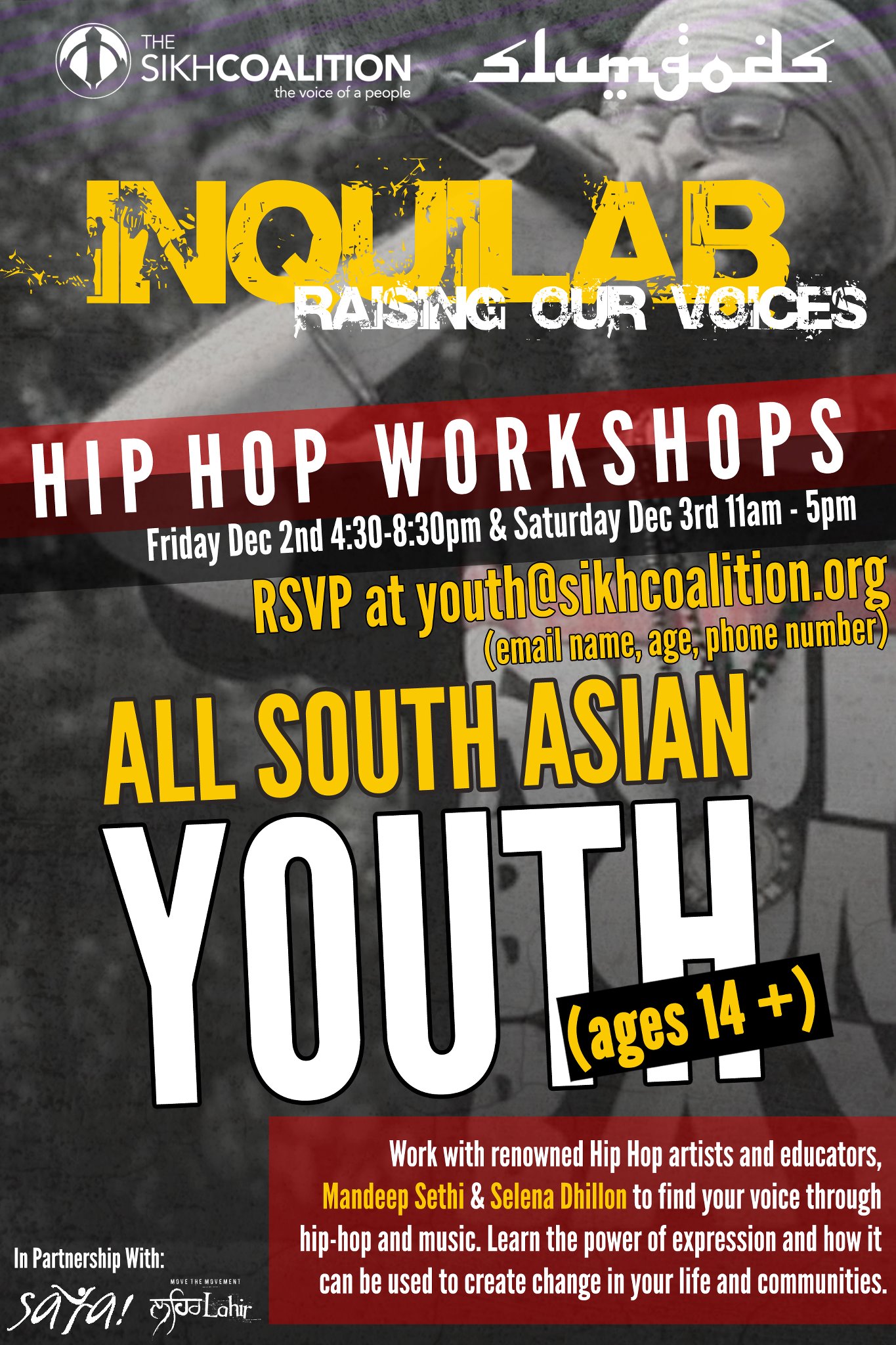 On December 2nd and 3rd, Sikh youth will have the opportunity to participate in a special workshop that will allow them to learn the power of expression and how it can be used to create change in their life and communities. Inquilab: Raising our Voices, organized by The Sikh Coalition and Slumgods, will bring together hip-hop artists, Mandeep Sethi and Selena Dhillon, to work with South Asian youth as a way of encouraging their engagement with expression. Through this participation, youth can learn how to effectively use art to inspire positive change within their own communities.
On December 2nd and 3rd, Sikh youth will have the opportunity to participate in a special workshop that will allow them to learn the power of expression and how it can be used to create change in their life and communities. Inquilab: Raising our Voices, organized by The Sikh Coalition and Slumgods, will bring together hip-hop artists, Mandeep Sethi and Selena Dhillon, to work with South Asian youth as a way of encouraging their engagement with expression. Through this participation, youth can learn how to effectively use art to inspire positive change within their own communities.
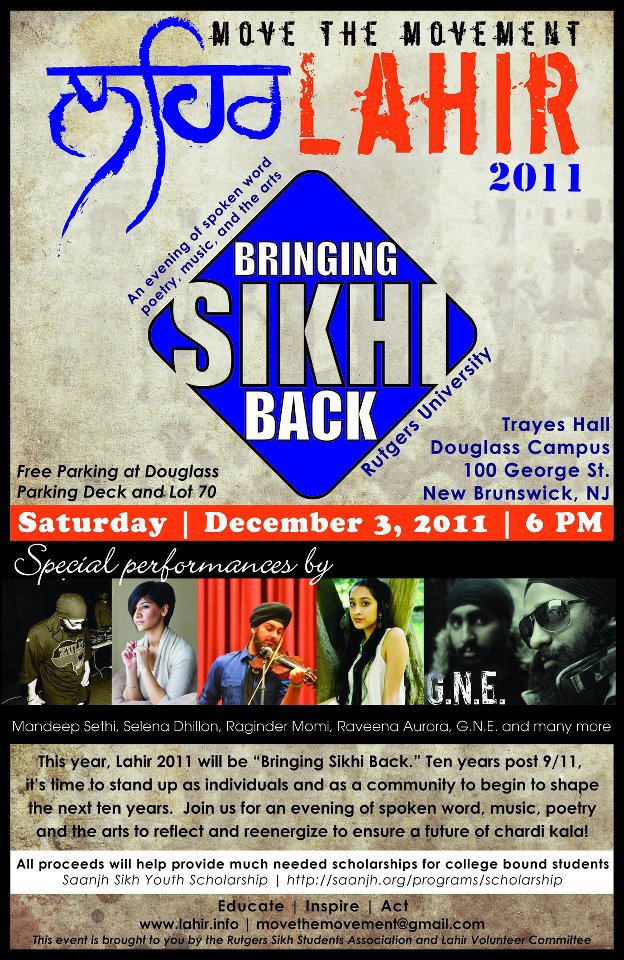 Following the workshop this weekend is Lahir – an event that aims to inspire, educate and awaken the community to rebuild the panth and encourage youth to become activists. The concert will provide a much-needed platform for powerful Sikh artists to express themselves through music, art, film, and poetry. Some more information from the organizers:
Following the workshop this weekend is Lahir – an event that aims to inspire, educate and awaken the community to rebuild the panth and encourage youth to become activists. The concert will provide a much-needed platform for powerful Sikh artists to express themselves through music, art, film, and poetry. Some more information from the organizers:
In past years, Lahir’s central theme focused on 1984 and Punjab. This year, Lahir 2011 will be “Bringing Sikhi Back”. Ten years post 9/11, it’s time to stand up as individuals and as a community to begin to shape the next ten years. Join us for an evening of spoken work, music, poetry and the arts to reflect and reenergize to ensure a future of chardi kala! This year, all proceeds will go to the Saanjh Sikh Youth Scholarship. We need strong voices in our community and we need diverse voices to help us educate others and ourselves about the historical, political, social, and economic issues that affect our community. Therefore, this event is not just for us, but for our future.
Inquilab will take place on December 2nd and 3rd 2011 at South Asian Youth Action Inc | 5405 Seabury St, Elmhurst, NY.
Lahir will take place on December 3rd 2011 at Rutgers University
We encourage you to learn more about these events, and if you are in the area – please attend and let us know how it goes!
When I met Sonny, I felt that his story demanded to be told. I was moved by his willingness to share difficult stories about how racism, xenophobia, and islamophobia impact him in a very daily and intimate ways. But more importantly, I was inspired by how he had turned this hardship into a motivation to fight for social justice for all people. I was welcomed with incredible warmth, and inspired by the Sikh traditions seeing the divine in all people, and fighting for equality. – Christina Antonakos-Wallace, Producer and Director of Article of Faith
To continue a discussion about bullying and bias-based harassment that seems to be appearing both here on The Langar Hall and also within langar halls across the nation, we wanted to take the time to highlight an inspiring documentary which discusses this very issue. Article of Faith is a short film, directed and produced by Christina Antonakos-Wallace, portraying one Sikh activist, Sonny Singh, who organizes New York City Sikh youth to combat harassment in their schools. Sonny shares his own, very personal experience with bullying recognizing how incredibly important it is for us to openly dialogue about these issues, so that other children who are experience similar challenges do not feel like they are alone.
Last week the US military officially ended “Don’t Ask Don’t Tell” (DADT) after President Obama signed a repeal of the 18-year-old anti-gay policy last December. Gay, lesbian, and bisexual service members (note the absence of transgender people, who are still not allowed to serve openly) and advocates of gay rights have been celebrating the repeal as a civil rights victory.
The day the repeal went into effect, President Obama stated:
Patriotic Americans in uniform will no longer have to lie about who they are in order to serve the country they love. Our armed forces will no longer lose the extraordinary skills and combat experience of so many gay and lesbian service members. And today, as Commander in Chief, I want those who were discharged under this law to know that your country deeply values your service.
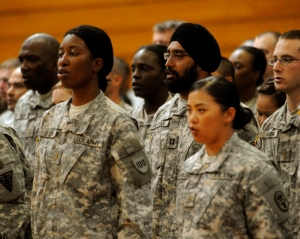
Captain Tejdeep Rattan at his graduation from the US Army basic training
This issue hits close to home for the US Sikh community, since the Pentagon’s uniform policy has not allowed Sikhs to serve with their kesh and dastaar since 1981. Similar to DADT, this is blatant discrimination and is an unacceptable policy for any employer, especially the federal government, which sets a powerful precedent for the rest of society.
Just as rights advocates have been fighting to end DADT for years (and finally succeeded), Sikhs launched a “Right to Serve” campaign in 2009, led by the Sikh Coalition and a Sikh doctor and dentist who were told by the Army to cut their hair when they report for basic training. The impressive efforts of Sikh cadets fighting for their rights and the tireless work of their advocates have resulted in the Army granting accommodations to three Sikhs, who are now serving with their turbans and unshorn hair in tact. The overall policy of the military nevertheless remains discriminatory.
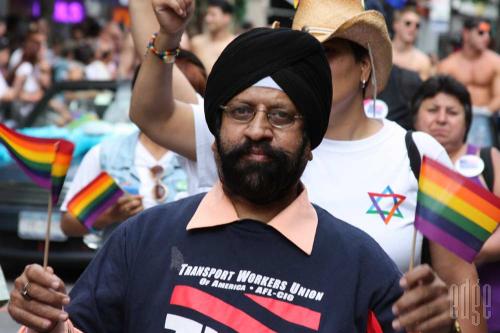
A friend sent me this photo yesterday from this past weekend’s annual LGBT Pride Parade in New York City, which was attended by about a million people. I’ve seen this Singh around NYC before. He happens to be one of the transit workers standing up to the NYC Transit Authority’s discriminatory “turban-branding” policy and now is also standing up for LGBT rights. Sikh solidarity seems to be in full swing lately.
The Pride festivities in NYC were a little different this year since they came just after state lawmakers voted in favor of legalizing gay marriage in New York last week. While some Sikhs (and Sikh institutions) have been outspoken about their opposition to allowing same-sex couples to marry, many others of us are celebrating this milestone civil rights victory in New York, seeing the fight for justice for LGBT people as no different as justice for women, people of color, or any other oppressed group.
Despite my previously alluded to reservations about the state sanctioning the way we structure our romantic relationships, households, and/or families, I believe that legalizing gay marriage is nevertheless a much needed blow to the deeply ingrained homophobia and heterosexism in our society. A lot more than marriage equality is needed to create the sort of radical transformation our Gurus envisioned for our world, but it is, at least today, a reason to say fateh!
A few years ago I was putting up some flyers on street poles and bulletin boards in Williamsburg, Brooklyn promoting an upcoming concert for my band. If you’re from New York City, you know Williamsburg is a neighborhood covered with concert flyers and band logos, and the home of dozens of music venues filled with indie rock-loving, skinny jeans-wearing hipsters (for the record, this has nothing to do with me nor my old band).
After a few minutes of putting up a bunch of flyers with tape, I was suddenly surrounded by 4 police cars and their flashing sirens. One of the cops approached me, while the others stayed close behind. He had one of our flyers in his hand and asked if I put it up. I said yes. He informed me this was “graffiti” and was illegal. I apologized and said I was not aware of that. He took my ID, talked to his colleagues, and the next thing I know I’m being aggressively handcuffed and put into the back of a police car without any explanation.
To make a long story short, I was arrested because a few years prior to the flyering incident, I got stopped and cited for riding my bicycle for a few feet on a sidewalk (in the rain) and never appeared in court for this egregious violation of the law and disturbance to the peace.
But this isn’t a story about why I got arrested and how ludicrous it is that these cops arrested me rather than asking me to please not put up flyers on street poles (which were already covered with flyers). This isn’t a story about racial or religious profiling and about if these (white) cops were driven by bias or if they were paying special attention to a turbaned, bearded brown man walking down a gentrified, newly predominantly white hipster block of Brooklyn.
This is a story about incarceration.
When I was taken to the precinct, still not knowing why I was arrested or what the hell was going on, I was aggressively and invasively patted down (more like groped) and searched by the officer who arrested me. After a few conversations with other officers at the precinct, I started putting the pieces together in my head as to why I was arrested, and they assured me that I’d be out of there in a few hours. I felt a bit relieved, though still anxious. I was hopeful that I could keep my head up and make it through this with my self-respect and dignity in tact.
Guest blogged by Navdeep Singh Dhillon
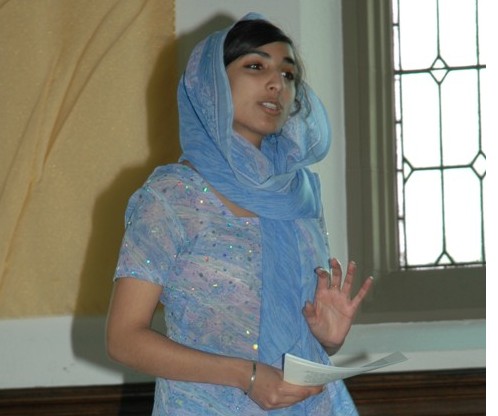 For my first post as a guest blogger, I wanted to address an issue that has been irritating me since September, when I first read about it. [An anonymous] Mehmaan wrote a post titled “Valarie Kaur, the peddler of self-promotion.” Mehmaan’s claim is essentially that Valarie Kaur is a big pakhandi.
For my first post as a guest blogger, I wanted to address an issue that has been irritating me since September, when I first read about it. [An anonymous] Mehmaan wrote a post titled “Valarie Kaur, the peddler of self-promotion.” Mehmaan’s claim is essentially that Valarie Kaur is a big pakhandi.
Mehmaan’s singular criterion for reaching the conclusion that Valarie Kaur is not just a pakhandi, but a big pakhandi, is that she is using social media and her website to promote herself as a speaker and to sell her documentary, “Divided We Fall,” inaccurately called a “movie” in the post.
I have never met Valarie and don’t know her family, but do want to clarify Valarie Kaur’s achievement, relegated to the realm of frivolity with the express purpose of making money, by Mehmaan in order to prove a point.
On September 11, the mood against anyone brown, especially Sikhs, changed drastically, and it culminated with the murder of Balbir Singh Sodhi on September 15. At that time, there was no Twitter. There was no Facebook. Even text messaging wasn’t normal everyday behavior. So there was no immediacy with information. I remember receiving emails through newsgroups I happened to be a part of documenting the steadily rising violence and blatant racism towards brown people. And then switching on my television to see zero updates on the “backlash.” Instead, it was just the same devastating image of planes crashing into the Twin Towers, followed by a turbaned and bearded Bin Laden. So what Valarie Kaur did at 20-years-old is nothing short of phenomenal. Along with her cousin, she went to document the brown experience on a cross-country trip, armed with plenty of panache, zero technical skills and a video camera. The fact is that there is no other documentary, which I am aware of, that weaves such a powerful narrative, intermingling a compelling personal story, and creating the link between not only Sikhs, but anyone of color, including the Japanese-American survivors of camps in the United States.
Late last week I received an email from the Sikh Coalition titled “Victory in Texas!!! 4.8 Million Students to Learn About Sikhi”. The email stated the following:
(May 21, 2010) Today, the Texas Board of Education voted to include information on Sikhs and Sikh practices in the state mandated curriculum for public school students. This marks a significant victory for the Sikh community as Sikhs and Sikhi has never before been included in the state-wide curriculum.
In 2011, Texas students will learn about Sikhs at three points during their public school education. Sixth graders will learn about Vaisakhi when they learn about Christmas, Yom Kippur, Ramadan, and Diwali. High school students taking World History will learn about the origin of Sikhism and its basic beliefs. Finally, high school students will also learn locations of large Sikh populations in their World Geography classes.
The email continues in its excitement:
Texas Greatly Impacts the Rest of America
Texas is a very influential state for textbook manufacturers. State curriculum standards determine the content that will be included in new editions. Experts estimate that the decisions made by the Texas Board of Education affect the textbooks used in 46 other states because it is one of the largest purchasers of textbooks in the nation. In effect, Texas curriculum standards shape the content students will learn across the entire nation.
In all the exuberance, should we take a breath for the possible ramifications?
Guest blogged by Brooklynwala
A few days ago, a friend sent me this powerful open letter she wrote in order to spark critical thinking and dialogue on the pitfalls of calling the police and relying on the criminal (in)justice system to deal with issues in our neighborhoods and communities. We live in New York City, which has a police force widely known for its excessive use of force and violence, especially against people of color. Sundari recently did a post on the NYPD shooting and killing of a Sikh man in NYC, Satnam Singh, just last week.
In a context in which police by and large cause more harm than get us closer to justice and where the prison system dehumanizes people instead of rehabilitating them, the author of this piece, along with a growing movement around the U.S., are challenging us to think of alternative ways of responding to harm. She states,
“Many of us don’t believe in calling the police. Right now, right here, even before we’ve sufficiently built all the alternative structures for responding to harm. Both in an attempt to create the world we want to live in, and/but also because the impact of prisons and policing is brutal, oppressive, racist, traumatic. We see almost no good coming of it, certainly no transformation, no making things better. We don’t trust police, we don’t think of them as the “good guys,” and we don’t think calling them is going to change anything.”
My friend’s compelling piece “Feeling for the edge of your imagination” got me thinking about what a Sikh approach to justice is. While there is clearly not a simple answer to this question, I tend to think a Gurmukh would place love, forgiveness, rehabilitation, accountability, and recognizing the Divine in all at the center, despite questionable or even horrific actions one has perpetrated. Think about Bhai Kanhaiya Ji’s seva for “enemy” soldiers in need, who saw the injured soldiers’ humanity before he sought vengeance for their attacks against the Sikhs.
 In some countries, those that perpetrate ‘crimes against humanity’ are punished. In India, too often (depending on the political party), the perpetrators are awarded at the ballot boxes or are decorated with cabinet positions. This is the story of Kamal Nath.
In some countries, those that perpetrate ‘crimes against humanity’ are punished. In India, too often (depending on the political party), the perpetrators are awarded at the ballot boxes or are decorated with cabinet positions. This is the story of Kamal Nath.
Kamal Nath is India’s current Union Cabinet Minister of Road Transport and Highways. It was on many of those same roadways in Delhi that Kamal Nath in 1984 personally led thousands of paid goons in the government-sponsored pogroms against the Sikhs. Thousands were bloodily massacred; thousands were raped; many lives destroyed and devastated. Many eyewitnesses have testified that Kamal Nath lead groups to attack the Sikhs seeking shelter at Gurdwara Rakab Ganj (the historic site where the body of Guru Tegh Bahadur was cremated after his shaheedi), killing many Sikhs and destroying the grounds of the Gurdwara.
Ensaaf’s report provides detailed information on Kamal Nath’s leadership and involvement during those dark nights in Delhi. The Sikh Activist Network in Canada (one of the spearhead groups in the coalition) has also prepared a short report, highlighting specific sections written by lead human rights attorney for the Delhi widows – HS Phoolka – in regards to the role of Kamal Nath.
Now, this month he has been invited to Toronto to lecture. As Sikhs, as Canadians, as people of conscious, as humans – we must act now.
Recent coverage on The Langar Hall led us to celebrate the victory in Surrey of the YOUTH SLATE. Now here in the United States we have the formation of the SIKH SLATE.
8 Sikh organizations (Ensaaf, the Jakara Movement, SALDEF, Sikhcess, Sikh Research Institute, Surat Sikh Conference, The Sikh Coalition, and United Sikhs) have teamed up and are calling on all Sikhs to vote for the slate on Facebook.
Just a few clicks could gain $200,000 for our community through the Chase Bank Community Giving.
CLICK HERE to vote and for links to all the Sikh organizations.
Now enjoy the Return of Billa in Part Deux and most importantly follow his advice – VOTE NOW!

Make sure you join the SIKH SLATE Fan Page on Facebook.
Please circulate widely to your family/friends (Sikhs and non-Sikhs)!
Last weekend I attended the Sikh Lens Sikh Art and Film Festival in Hollywood. I have attended film festivals all over North America and strongly believe in their need and presence in our community. Many times, however, the events get overshadowed by the glitz and glamour – the red carpet, the photographers, the eccentric outfits… I was therefore grateful that my experience at the Sikh Arts and Film Festival was a fulfilling one – I left knowing that Sikh Arts and Films bring value to our community and need to be supported. In addition, I felt the organizers made a special effort to keep the event focused on the directors, artists, musicians, actors, authors and organizations who were present. They recognized the fact that we are all in this together. Sikh Arts and Films are only beginning to be acknowledged, there is so much potential and growth that will still occur. However, this isn’t going to magically happen overnight, and it most definitely won’t happen without the community’s support.
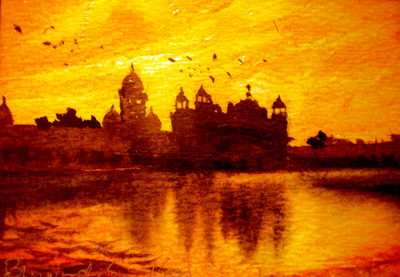 I was recently told that Sikhs in the UK spend 7 times more on license plates than they do on books (yes, 7 times!). While I’m not sure of the statistic in the US, the point is clear – perhaps we’re not investing in the right places? I think as a community we have begun to establish the need to support non-profit organizations that are working to address human rights, legal, education and activism issues (although we still have a long way to go to enhance our support). However, what goes hand in hand with this is the support and advancement of Sikh Art and Media. Without a doubt, events such as Sikh Lens are helping to pave the path – however, we as a community need to ask ourselves why we are so hesitant to spend money on independent films, children’s books, on historical references and on paintings. When I think about other immigrant communities, I notice that their advancement as a community comes from their support of one another. Whether we like to admit it or not, our community is extremely frugal and competitive with each other, and unless we start to move away from those stereotypes – we will not be creating a better world for our children.
I was recently told that Sikhs in the UK spend 7 times more on license plates than they do on books (yes, 7 times!). While I’m not sure of the statistic in the US, the point is clear – perhaps we’re not investing in the right places? I think as a community we have begun to establish the need to support non-profit organizations that are working to address human rights, legal, education and activism issues (although we still have a long way to go to enhance our support). However, what goes hand in hand with this is the support and advancement of Sikh Art and Media. Without a doubt, events such as Sikh Lens are helping to pave the path – however, we as a community need to ask ourselves why we are so hesitant to spend money on independent films, children’s books, on historical references and on paintings. When I think about other immigrant communities, I notice that their advancement as a community comes from their support of one another. Whether we like to admit it or not, our community is extremely frugal and competitive with each other, and unless we start to move away from those stereotypes – we will not be creating a better world for our children.
 Guestblogged by Mewa Singh
Guestblogged by Mewa Singh
This past weekend the North American Sikh Medical and Dental Association (NASMDA) held their 17th annual conference in San Diego, CA. The organization’s website provides a brief description:
Started in the summer of 1992 at Poncos, Pennsylvania, NASMDA has grown to an organization of over 1000 Sikh medical and dental professionals spread across North America. NASMDA strives to provide a platform for Sikh medical and dental professionals to network and interact with each other while promoting the ideals and the mission of Guru Nanak. The members of NASMDA have been actively involved with helping out and supporting various Sikh organizations, young medical students and physicians.[link]
NASMDA provides a platform for Sikhs of various ages to engage in medical exchanges as well as be briefed by various organizations that presented. In all transparency, I made one such presentation, along with other organizations, including Sikh Coalition and more.
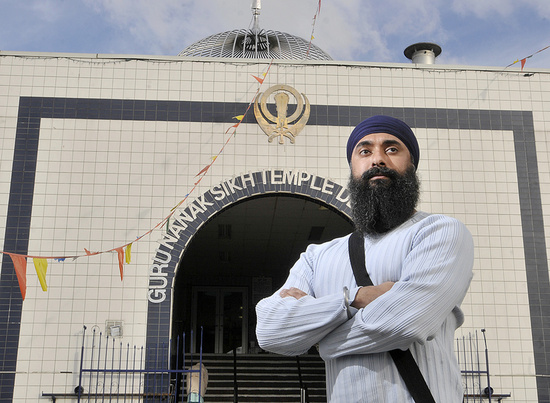 Many of the elements that make up this article have been featured in the Langar Hall in the past – Ranj Dhaliwal’s book Daaku about the lifestyle of Punjabi gangsters, thugs, and drug-dealers in BC during the late 1990s and early 2000s that cost the lives of 100+ youth in our community, Mani Amar’s film “A Warrior’s Religion” that documents the real life stories and effects of the peak of the violence, and finally to the various twists and turns that is British Columbia’s Sikh politics – from new coalitions to disputed certifications.
Many of the elements that make up this article have been featured in the Langar Hall in the past – Ranj Dhaliwal’s book Daaku about the lifestyle of Punjabi gangsters, thugs, and drug-dealers in BC during the late 1990s and early 2000s that cost the lives of 100+ youth in our community, Mani Amar’s film “A Warrior’s Religion” that documents the real life stories and effects of the peak of the violence, and finally to the various twists and turns that is British Columbia’s Sikh politics – from new coalitions to disputed certifications.
However, a recent article in The Walrus, author Timothy Taylor brings all these elements together in his piece, titled “Showdown on Scott Road.”
We are seeing how political power is harnessed and used by the Sikh community as we engage in more civic engagement projects initiated by our own Sikh institutions. Civic engagement is not new to our community per se. The first Asian congressman was a Sikh-Dalip Singh Saund. As a child I remember local Sikh business leaders and professionals brought governmental representatives to our Gurudwaras to give speeches. These politicians were later recogonized with a saroopa and more opportunities to address their Sikh constituency at mela award ceremonies that seemed to last longer than the actual musical performances. Often these politicans were talking in English to a community that primarily understood Punjabi. It seemed more like an opportunity for the local Sikh leaders to secure their political connections for their own business interests than really an opportunity to hold politicians accountable to meeting their Sikh constituency’s needs. These political connections were often rooted in the capacity of the Sikh “leaders” to donate money than actually represent the needs of the Sikh community in a sustained way. I don’t want to paint this picture with too broad of a brush stroke because there are some Sikh business leaders, professionals, and activists who did build political power in our community to meet our needs; but they are definitely a minority. These Sikhs pushed along despite all the obstacles of being immigrants, They should serve as inspiration for the new generation of Sikh activists. This new generation needs to remember that we are not breaking as much untouched ground as we sometimes think we are doing. Our work should attempt to build off of those who came before us.
A nice piece in the Columbia Journalist discusses the challenges incurred by young Sikh men and women as they navigate through their adolescent years. The article tells us of two friends, Sonu Singh and Manjinder Singh, who have bonded over their love of hip-hop, video games, and (of course) girls. However, as the article notes, what sets these friends apart is the fact that while Manjinder chooses to keep his kesh, Sonu plans to grow his hair and wear a pagh later on in life.
Sonu and Manjinder embody a larger tension within the Sikh community – the internal dilemma among children to remain true to their faith while still fitting in with their peers. After the terrorist attacks of September 11, 2001, some Sikhs simply do not want to stand out. Incidents of harassment and discrimination towards Sikhs students have increased dramatically since then…
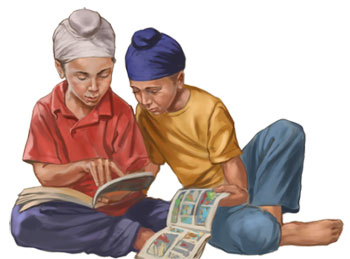 The article talks about the various cases of harassment and bullying which have taken place in New York City schools. The Sikh Coalition has stated that almost half of students who wear paghs have experienced physical violence in school. Yes, half! While bullying affects children of all ethnic groups, it is clear that Sikh children feel especially vulnerable. In addition, many young Sikh children don’t feel that they are adequately equipped to deal with harassment targeted at their physical appearance.
The article talks about the various cases of harassment and bullying which have taken place in New York City schools. The Sikh Coalition has stated that almost half of students who wear paghs have experienced physical violence in school. Yes, half! While bullying affects children of all ethnic groups, it is clear that Sikh children feel especially vulnerable. In addition, many young Sikh children don’t feel that they are adequately equipped to deal with harassment targeted at their physical appearance.
Early last week, a remarkable thing happened. Sikh children took to NYC streets again- some in strollers- and they were heard.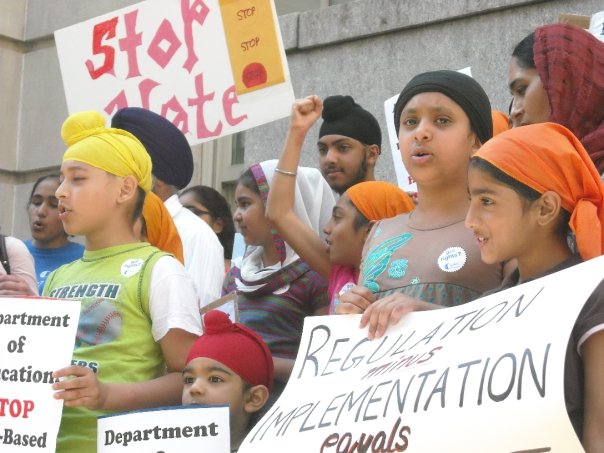
Last fall, the New York Department of Education passed a regulation in response to disturbing findings about the bullying that Sikh children face in schools. The regulation promised to define, track, and prevent bias-based harassment in NYC public schools. So after the first school year in which the regulation was in effect, how did the schools measure up?
The results were made public at a recent press conference by the Sikh Coalition and Sikh youth in NYC in front of the Department of Education’s headquarters. The Sikh Coalition teamed up with area organizations including the Coalition for Asian American Children and Families (CACF) and the Asian American Legal Defense and Education Fund (AALDEF), to release a report card grading the first year of the regulation’s implementation. Speakers at the press conference included representatives from Queens and Brooklyn schools and organizations such as the New York Civil Liberties Union (NYCLU), Desis Rising Up and Moving (DRUM), and Make the Road NY.
Problems remain, the report card shows. Based on the Sikh Coalition’s survey, there was no significant decline in the rate of harassment in the first year of the regulation’s implementation. [pg.9] Perhaps most disturbingly, out of all harassment reported by children, 16% was committed by a school official such as a teacher, school staff member, or security officer. [pg.12] In addition, after 90% of reported incidents of harassment to school officials, the school failed to properly follow protocol for investigation and follow-up. [pg.11]
For the full report card, click here.
 Things are heating up as Sikh transit workers organize against the MTA’s requirement that Sikh workers wear an MTA logo on their turbans. The rationale? The MTA’s position is that this policy is necessary for customers to identify their employees. However, neither the NY City Council, nor the U.S. Department of Justice, is buying this baloney. The 27 of the City Council’s 51 members recently voted to sign onto a letter to the MTA President, opposing the policy, and the Department of Justice has revived an employment discrimination case against the MTA.
Things are heating up as Sikh transit workers organize against the MTA’s requirement that Sikh workers wear an MTA logo on their turbans. The rationale? The MTA’s position is that this policy is necessary for customers to identify their employees. However, neither the NY City Council, nor the U.S. Department of Justice, is buying this baloney. The 27 of the City Council’s 51 members recently voted to sign onto a letter to the MTA President, opposing the policy, and the Department of Justice has revived an employment discrimination case against the MTA.
There are, of course, many ways that customers can identify MTA workers, from the badges they may wear, to a uniform vest, to a standard outfit. So why attempt to brand the turban, specifically? This policy shift, along with previous failed attempts, is indicative of the MTA’s general hostility to religious inclusion and work staff diversity.
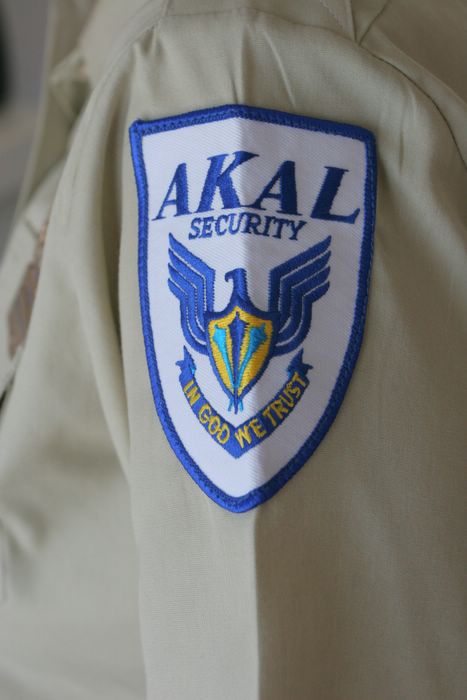 Just before the weekend, NPR featured a story on Akal Securities and the Sikh community in New Mexico. The article discusses the success of a number of businesses that help support the 3HO organization. It is partly due to these generous contributions by community members and leaders of these businesses that as a community we benefit from the inspiring resources such as Sikhnet.com. As an attendee at the annual Los Angeles Vaisakhi Nagar Kirtan, I have witnessed the beautiful display of the Sikh community, largely led by members of the 3HO, year after year.
Just before the weekend, NPR featured a story on Akal Securities and the Sikh community in New Mexico. The article discusses the success of a number of businesses that help support the 3HO organization. It is partly due to these generous contributions by community members and leaders of these businesses that as a community we benefit from the inspiring resources such as Sikhnet.com. As an attendee at the annual Los Angeles Vaisakhi Nagar Kirtan, I have witnessed the beautiful display of the Sikh community, largely led by members of the 3HO, year after year.
For those familiar with Akal Securities, you can find their ubiquitous khanda symbol everywhere. From airports, to security guards in front of Target, I have had a sense of pride whenever I see their logo. It is a tremendous example of our Sikh brethren being successful and specifically an example of individuals that use their success to contribute to the Sikh community in general. This is not to say that the company has not had its share of problems (and successes), but still I believe it is a model and a successful one and deserves recognition.

